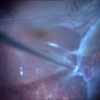
Strabism
Strabism
What is it?
It is a disorder in which the two eyes do not line up in the same direction. Therefore, they do not look at the same object at the same time. One eye looks straight ahead while the other eye is turned in, out, up, or down.
The eyeball is surrounded by 6 muscles, working together and in a coordinated way, which are responsible for its mobility, allowing both eyes to focus on the same object.
In a child with strabismus, these muscles do not work in a coordinated way. As a consequence, one eye is focused on the object, while the other looks in a different direction. When this happens, the brain receives two different images (one from each eye). In children, the brain can learn to ignore (suppress) the image from the weaker eye, which can lead to amblyopia (lazy eye).
Causes
It is a complex pathology that is produced by an alteration of the cerebral control over the position of the eyes. In most children with strabismus, the cause is unknown.
There are strabismus of hereditary type and others acquired after problems in the muscles or in the nerves of the muscles (paralysis of a nerve) or by problems in the optical graduation of the eyes.
Types of strabismus
There are several types of strabismus. Generally speaking, strabismus is described based on the direction of the eye’s deviation. In this way we have:
· Convergent strabismus (Esotropia): the eye deviates inwards.
· Divergent strabismus (Exotropia): The eye deviates outwards.
· Hypertropia: The eye deviates upwards.
· Hypotropia: The eye deviates downwards.
Strabismus can be constant or intermittent. Misalignment can also always affect the same eye (unilateral strabismus) or the two eyes can be misaligned one at a time (alternating strabismus).
Can strabismus be prevented?
There are certain risk factors associated with strabismus:
· Family history of strabismus, lazy eye, or high hyperopia.
· Premature children.
· High hyperopia.
· Important difference in optical graduation between both eyes (anisometropia).
Symptoms
The main sign of strabismus is a visible misalignment of the eyes.
Strabismus frequently causes a lazy eye, as well as difficulty in seeing in three dimensions and in calculating distances. Characteristic signs and symptoms of strabismus are:
· The eyes do not line up in the same direction (each eye looks in a different direction).
· Diplopia (double vision).
· Uncoordinated eye movements (eyes do not move together).
· Visual acuity reduction.
· Inability to perceive objects in three dimensions.
· Reading problems (child may skip lines when reading).
It would be important to highlight that children will probably never realize they have double vision, as they develop amblyopia (lazy eye) quickly.
Diagnosis
It is very important to make an early diagnosis. Tests to detect strabismus can be done shortly after birth.
A complete ophthalmological examination will be performed, paying special attention to the exploration of visual acuity and optical graduation (to detect a possible lazy eye) and ocular motility. The perfect alignment of the eyes and ocular motility must be evaluated. A very important test is the occlusion / unocclusion test, in which one eye is briefly occluded (2-3 seconds) and observed for movement. Sometimes it may be necessary to perform other complementary tests to diagnose strabismus.
Prognosis
In most cases, the problem can be corrected if it is found and treated early. The prognosis depends mainly on the age of diagnosis and the type of strabismus. The sooner strabismus is diagnosed and treated; the better results will be obtained.
It is important to note that if the child has developed amblyopia, the eyes may be perfectly aligned, but vision defects may continue. Hence the importance of early diagnosis.
Although it is initially resolved, some children may suffer strabismus again during their adulthood (mainly associated with problems of stress, fatigue, etc.), therefore it is necessary to carry out periodic check-ups.
Treatment
In most cases, the only effective treatment for strabismus is surgery.
The success of strabismus surgery depends on many factors, such as the direction and extent of the eye deviation. In some cases, more than one surgical procedure may be needed. Performing a surgical intervention “on time” can be key to the development of normal visual acuity in both eyes (avoid lazy eye) and makes the eyes work together and in coordination.
In some cases of small-angle, intermittent strabismus, it may be possible to improve the alignment of the eye without surgery, with vision therapy.
In some patients, a joint treatment may be indicated, in which a program of vision therapy is carried out after a surgical intervention.
Different strabismus treatment options and strategies include:
· Correction of refractive errors using corrective lenses (glasses).
· Treatment of lazy eye (patches, penalties, atropine).
· Use of special glasses (prismatic glasses) to reduce / alleviate diplopia (double vision).
· In some types of strabismus, treatment with botulinum toxin A injections may be indicated (produces muscle paralysis that compensates for the strabismus).
· Surgery of the extraocular muscles (those responsible for ocular motility).

